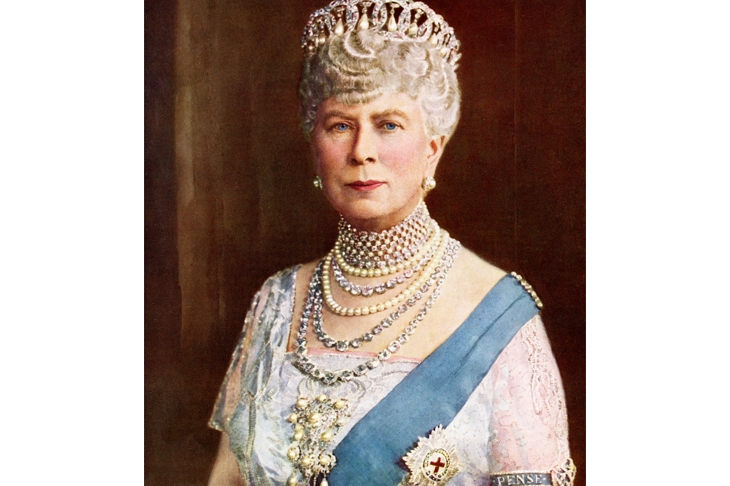The best royal biography ever written is probably James Pope-Hennessy’s Queen Mary. Published in 1959, only six years after the queen’s death, it is a masterpiece: no one has written better about her German relations, about her larger-than-life mother, Fat Mary, the Duchess of Teck, or about the royal family in the early 20th century. It is an astonishingly candid book, considering that it was published at the time when the royal code of secrecy was at its height. The greatest tribute to the author is that no serious life of Queen Mary has appeared since.
Pope-Hennessy didn’t actually want to write the book. When the royal librarian Owen Morshead asked him to do it, his first instinct was to refuse. He was an unlikely choice for the job. Someone described him as ‘two characters lodged in one shell’. One was the hard-working professional writer, the witty talker and confidante of smart women such as Maud Russell or Anne Fleming. The other Pope-Hennessy was a man driven by ‘unremitting homosexuality’ into low life, consorting with rent boys.
In 1974 his flat in Ladbroke Grove was broken into by three men after someone overheard him boasting about the advance he had received to write a biography of Noël Coward. They thought the cash was in the flat. It wasn’t. But Pope-Hennessy was murdered. He was 57.
In this fascinating book Hugo Vickers publishes the interviews made in the process of researching Queen Mary. Pope-Hennessy was astute in using his commission as royal biographer to gain access to old royals and members of Queen Mary’s household. He soon realised that these interviews in themselves formed the material for another book. Because of the secrets and indiscretions they contained, he stipulated that they should not be made public for 50 years. A few of the interviews were published by Peter Quennell in 1980, but Vickers’s superbly edited text is the complete version.
The pieces are uneven. Some of the interviews are research notes, sketchy and brief. There are some splendid Queen Mary remarks. On the Abdication: ‘This might really be ROUMANIA.’ On punctuality: ‘Why should anybody be late? I know exactly how long it takes me to dress.’
The picture that emerges is not altogether favourable. The Duchess of Devonshire, who was Mistress of the Robes for more than 40 years, claimed that in all that time she only once had a relaxed conversation with the queen. Maggie Wyndham, a Woman of the Bedchamber, whose duty it was to read aloud to the queen, was sometimes made to do so for seven hours non-stop. Lord Claud Hamilton said that Queen Mary was ‘one of the most selfish human beings I have ever known’.
The cold, lonely, proud queen dressed up in Garter ribbon and diamonds for dinner at Sandringham every night, even when alone with the king. But her not-so-loyal household didn’t mention the one thing that people say nowadays when Queen Mary’s name comes up: oh she was the one with kleptomania; when she admired something in your house you had to give it to her. Perhaps that is a modern myth.
The longer pieces which Pope-Hennessy worked up as essays for publication are brilliant. Like all the best interviews, these are stories about the hunter circling his prey, and they reveal as much about the interviewer as his subject. At Sandringham, he couldn’t resist sneering at the ‘suburban, middle-class’ York Cottage into which George V and Queen Mary squeezed for most of their reign. Pope-Hennessy’s judgment is not always to be trusted. He admired the Duke of Windsor, whom he thought ‘exceedingly intelligent’ and ‘liberal-minded’, which seems to be over-egging things a bit.
He had a novelist’s ear for dialogue and some of the essays are wickedly funny. My favourite describes his weekend with Prince Henry Duke of Gloucester at Barnwell Manor. The Duke, says Pope-Hennessy, is ‘one of the finest and most authentic specimens of the [royal] race available today’, with bulging Guelph eyes and a pine-apple-shaped head like William IV. He was also very kind and very entertaining, with an infectious laugh like a ‘hysterical piglet squeal’, and he sat up each night with Pope-Hennessy until two or three in the morning, gossiping about his relations — the wonder is that Pope-Hennessy was able to write down their conversations word for word in the next day.
Queen Mary spent the war at Badminton, and the Duchess of Beaufort interview is a gem. She describes the queen sitting in the air-raid shelter in the middle of the night, perfectly dressed with her pearls and doing the crossword while her lady keeled over beside her. That was the stuff she was made of, and this is a splendid book.






Comments